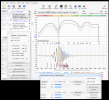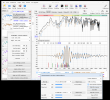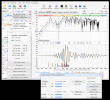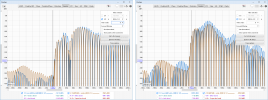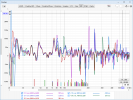The other day I was testing the response of one of my speakers at different distances from the side wall. I've been looking at the results in different ways and thought to use FDW (frequency dependent window). The 2 and 3 cycle windows showed 2 specific nulls that steadily lowered in frequency as the distance from the closest wall increased, which makes sense (longer distance to wall = lower frequency). The thing is, when I drew up the speaker positions and frequencies in CAD, that distance (1/4 cycle of null centre) doesn't match the "wall" (or the wall with window recess in my case). But it does seem to be pretty consistent at some place beyond the window.
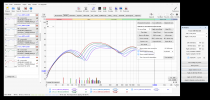

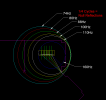

I checked SBIR Calc, and the test closest to the wall is 400mm from the wall, or 540mm from the window. 540 gives first null at 159Hz on the calc, and manually doing the calculation it's 343/0.54/4=159Hz. But the problem frequency for the 400 test is quite obviously not 159Hz, but ~110Hz, which is 780mm 1/4 cycle length. Also the second null is at ~550Hz, which is the "5/4 cycle" of the same reflection, so 343/550/4*5=780mm.
So the problem seems to be consistent, but it just doesn't align with the wall. I checked with the tape measure, but it doesn't match any corners (wall to wall, wall to ceiling, etc) or edges (wall to window recess). Any ideas what is going on?
Here's a few more graphs showing the problem. The distortion peak at 90Hz seems pretty common, I'm not sure if it could be relevant?
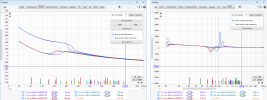





I checked SBIR Calc, and the test closest to the wall is 400mm from the wall, or 540mm from the window. 540 gives first null at 159Hz on the calc, and manually doing the calculation it's 343/0.54/4=159Hz. But the problem frequency for the 400 test is quite obviously not 159Hz, but ~110Hz, which is 780mm 1/4 cycle length. Also the second null is at ~550Hz, which is the "5/4 cycle" of the same reflection, so 343/550/4*5=780mm.
So the problem seems to be consistent, but it just doesn't align with the wall. I checked with the tape measure, but it doesn't match any corners (wall to wall, wall to ceiling, etc) or edges (wall to window recess). Any ideas what is going on?
Here's a few more graphs showing the problem. The distortion peak at 90Hz seems pretty common, I'm not sure if it could be relevant?




